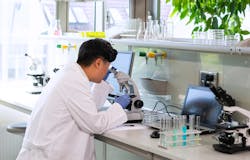Key points of intersection in diagnosis and treatment of cancer
With the advancement and expanded uses of technology in the laboratory we have a host of opportunities in the hands of physicians and scientists to explore and study diseases in-depth and in a way that we historically have not been able to. We are seeing an unprecedented application of these technologies combined with the expertise of these human resources to open those avenues and take deeper dives into the study and understanding of tumors and cells and their behaviors, having a significant impact on the diagnosis and treatment plans for patient populations.
What are microbes and how do they play a key role in the diagnosis and treatment assumptions for cancer now? Without being condescending, or as a refresher, microbes can be both helpful and harmful in the human body — they can cause diseases like cancer, or they can help with inhibiting disease and promoting health. Their role and relationship with cells, tumors, and the immune system can vary greatly. They help with the diagnosis of cancer by producing biomarkers, which are found in bodily fluids and are therefore easy to test for and to identify. Some also produce toxins which damage cells and can cause them to mutate where this can both cause cancer and be an early predictor for cancer in diagnosis. Other early detectors or indicators for diagnosis are microbes that naturally create contrast elements; these help reveal tumors by producing light or magnetic elements that are highly visible in diagnostic images.
There are bacteria that have the ability to impact the body’s own immune system, either negatively by suppressing it or positively by boosting it, in both cases, impacting how the body both responds to cancer cells and their development or progression and in how the patient will respond to specific therapeutics. By increasing the body’s response to immunotherapy drugs, they are increasing the effectiveness of the drug and the body’s defense against the tumors. Conversely, bacteria can also suppress the body’s immune system and reduce its ability to fight the development of the cancer, or they can reduce the toxicity of chemotherapy drugs, also having a negative impact on the ability to reduce the cancer’s development in a given patient.
When we combine that with disciplines like next-generation sequencing, we have a roadmap for studying tumors, host genomes, and the microorganisms that subsist within them. We are now learning that these microbes may communicate or have an interactive relationship with certain cancers. This leads to the possibility that they may also have the ability to direct or control the response to specific treatments.
Microbiome data can be used to identify certain tumor signatures and biomarkers, which can be used to determine cancer risk as well as provide insights for how those tumors will respond to specific therapeutics or even to determine the most likely outcome for a patient. This information is extremely valuable in the diagnosis and treatment plans for patients but also for researchers and drug and pharma companies in the development and testing of new therapies. Incorporating the ability to target microbiomes in research and clinical trials will enable us to see how the microbiomes interact with, or direct, the tumors response to different cancer treatments. The treatments currently being investigated include both transplantation and precision-guided molecular applications. Some of these findings can include predictors for developing toxicity in treatments and how those interplay with increased, or decreased, microbiome response.
Another approach for study and research includes the relationship between microbes and their responsibility for cancer developing or in the progression of it within the body. It is known that certain bacteria have been directly associated with certain types of cancers such as colorectal and oral. The ability to manipulate or interfere with these bacteria using technological advances and information can help identify the impact of certain treatment plans, based upon understanding the microbiomes response. We are gaining a great deal of information, through technology, on how they respond to specific tumor and treatment combinations. Bacteria and fungi that live around tumors help those tumors thrive and grow while others can work together with specific treatments to help the body’s immune response to tumors, which can render treatment more effective. 1234
The opportunity for the development of new, personalized treatments through the use of technology focused on this subject is extensive now. These could have a significant impact on the outcomes, longevity, and eradication of cancer for patients. Immunotherapy is an area that has become widely focused on for research and development due to the number and results of studies with microbiomes. As the information regarding their uses and responses to cancers and immune responses becomes readily available and shared, it becomes more a part of the drug development pipeline.
The focus of scientists and researchers is really on the two use cases for immunotherapy in cancer:
- Enhancing, or strengthening, the innate defenses of the immune system so it is better able to find and fight cancer cells
- Creating manufactured elements that mimic, but are better targeted, immune system structures for use in improving how the immune system works to locate and fight cancer cells
Using immunotherapy to treat cancer is not new, this has been a focus and an option for therapy for several years, but the advancement of technologies such as imaging, digital pathology, and artificial intelligence has provided new ways of approaching treatment development and new ways of working with the immune system. These technologies have also had a significant impact on the speed of discovery, development, and testing of these techniques.
As we have covered, immunotherapy works better on certain types of cancer than it does on others — but the focus is also on the current understanding of how it works better when used in combination with some treatments versus others.
As a summary, we can look at the different types of immunotherapies being used in the treatment of cancer today. Keeping in mind that certain types of cancer use different types of targeted immunotherapies and there are several being developed and in research today.
Types of cancer immunotherapy
- Checkpoint inhibitors: These drugs basically take the ‘brakes’ off the immune system, which helps it recognize and attack cancer cells.
- Chimeric antigen receptor (CAR) T-cell therapy: This therapy takes some T-cells from a patient's blood, mixes them with a special virus that makes the T-cells learn how to attach to tumor cells, and then gives the cells back to the patient so they can find, attach to, and kill the cancer.
- Cytokines: This treatment uses cytokines (small proteins that carry messages between cells) to stimulate the immune cells to attack cancer.
- Immunomodulators: This group of drugs generally boosts parts of the immune system to treat certain types of cancer.
- Cancer vaccines: Vaccines are substances put into the body to start an immune response against certain diseases. We usually think of them as being given to healthy people to help prevent infections. But some vaccines can help prevent or treat cancer.
- Monoclonal antibodies (mAbs or MoAbs): These are man-made versions of immune system proteins. mAbs can be very useful in treating cancer because they can be designed to attack a very specific part of a cancer cell.
- Oncolytic viruses: This treatment uses viruses that have been modified in a lab to infect and kill certain tumor cells.
REFERENCES
1. BBC - Homepage. BBC. https://www.bbc.com/. Accessed September 28, 2023.
2. National geographic. Natl Geogr Mag. Accessed September 28, 2023. http://nationalgeographic.com.
3. Fred Hutchinson Cancer Center. Fred Hutch. Accessed September 28, 2023. http://fredhutch.com.
4. ScienceDaily: Your source for the latest research news. Science Daily. Accessed September 28, 2023. http://sciencedaily.com.
5. Information and resources about for cancer: Breast, colon, lung, prostate, skin. Cancer.org. Accessed September 28, 2023. https://www.cancer.org/.
About the Author

Lisa-Jean Clifford
Lisa-Jean Clifford has been a noteworthy leader in the high-tech healthcare solutions space for more than two decades. Lisa-Jean’s passion for making a positive impact on the lives of patients through technology can be traced back to her tenure at McKesson and IDX, now GE Healthcare, where she served in vital business development and marketing roles, and to Psyche Systems, an LIS solution provider, where she was the CEO for eleven years. She is currently the President at Gestalt Diagnostics.
Now, recognized as an industry expert, she actively participates in numerous boards including the Association of Pathology Informatics where she serves as President and MLO’s Editorial Advisory Board. She is widely published in many top laboratory publications and noteworthy news sources, such as Forbes, CAPToday, Medical Laboratory Observer, and Health Data Management. Also, she is a highly sought-after speaker and focuses on delivering valuable content in critical areas such as lab automation including software and interoperability, digital pathology, AI in pathology, lab informatics, oncology, and women’s health.
